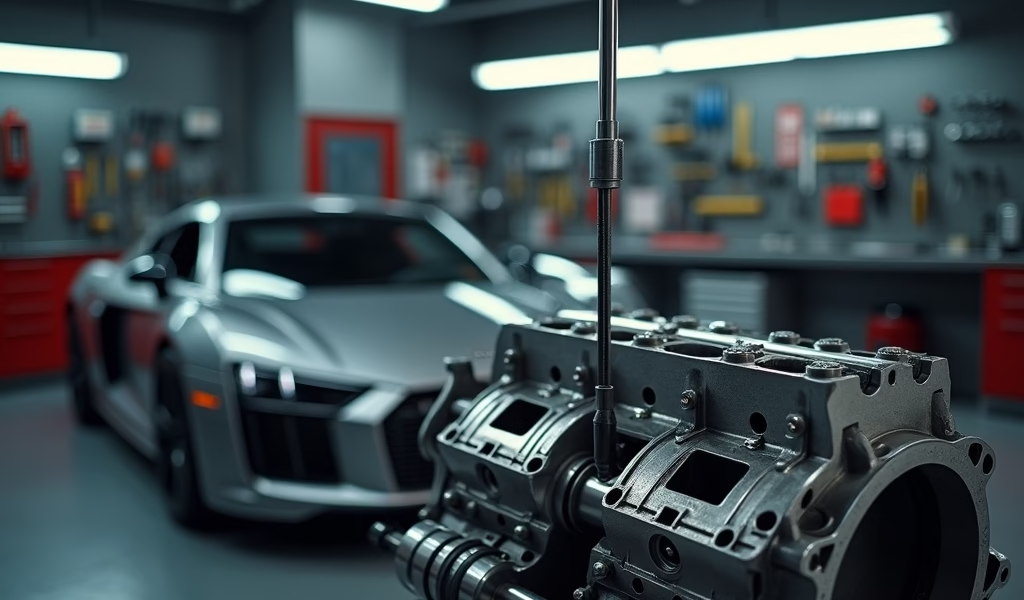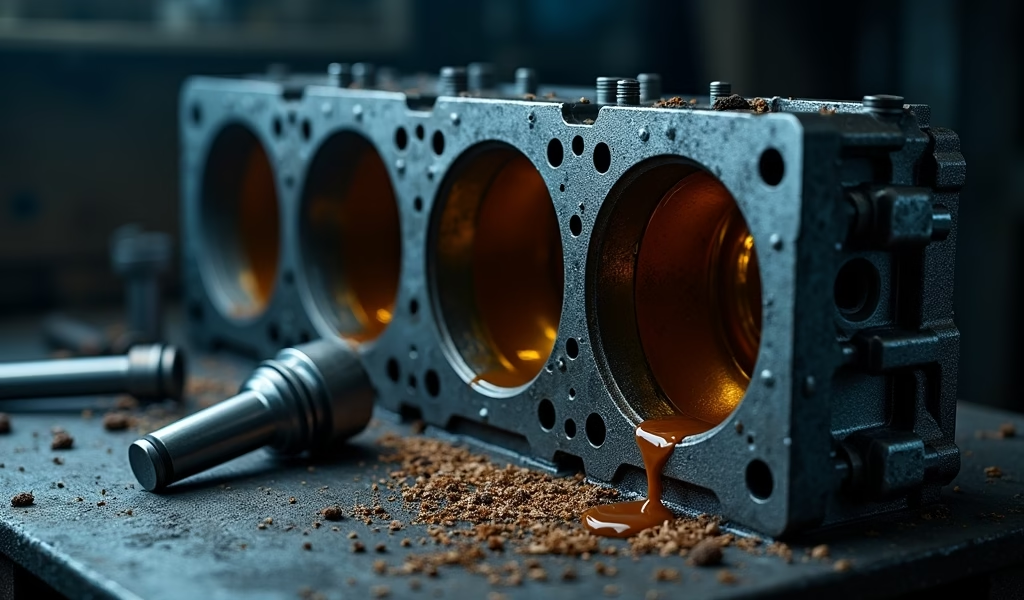Overview
This article explains cylinder bore taper in engines—a condition where cylinders aren’t perfectly straight, causing power loss, oil consumption, and blue smoke—and outlines five repair options: honing, boring, sleeving, block replacement, and preventative maintenance. Proper measurement is crucial for diagnosis, with repair costs ranging from $100-200 for professional honing of a four-cylinder engine to $1,000-2,500 for complete rebuilding with boring.
Table of Contents
- Understanding Cylinder Bore Taper
- Why Cylinder Taper Matters
- Measuring Cylinder Bore Taper
- Five Effective Fixes for Cylinder Bore Taper
- Fix #1: Cylinder Honing
- Fix #2: Cylinder Boring
- Fix #3: Cylinder Sleeving
- Fix #4: Engine Block Replacement
- Fix #5: Preventative Maintenance
- Comparing Costs of Different Fixes
- Conclusion
- Frequently Asked Questions
Understanding Cylinder Bore Taper
When it comes to engine performance problems, cylinder bore taper measurement is one of those critical diagnostics that separates weekend tinkerers from seasoned mechanics. I’ve seen countless engines roll into my shop suffering from mysterious power loss, excessive oil consumption, and blue smoke—all classic symptoms of cylinder taper issues.
So what exactly is cylinder bore taper? Simply put, it’s when your engine’s cylinders aren’t perfectly straight up and down. Instead of having a consistent diameter from top to bottom, a tapered cylinder is slightly conical—usually wider at the top than the bottom. This seemingly minor imperfection can wreak major havoc on your engine’s performance.
Over my 25 years working on engines, I’ve found that many vehicle owners overlook this invisible enemy until it’s caused significant damage. Let’s break down what you need to know about identifying and fixing this common but serious engine issue.
Why Cylinder Taper Matters
Your engine block houses the cylinders—those mechanical chambers where the magic of combustion happens. When those cylinders develop taper, it’s like trying to seal a leaky bucket with an ill-fitting lid. Your piston rings simply can’t maintain proper contact with the cylinder walls throughout their travel.
What’s considered “too much” taper? Most manufacturers specify that anything beyond 0.001″ to 0.002″ (that’s one to two thousandths of an inch) is problematic. This might sound minuscule, but in the precision world of engines, it’s the difference between smooth power and serious troubles.
When cylinder taper exceeds acceptable limits, several problems emerge:
- Compression loss due to gases escaping past the rings (known as “blow-by”)
- Increased oil consumption as oil sneaks upward past the rings
- Reduced power output and fuel efficiency
- Accelerated piston ring and cylinder wall wear
- Blue or gray exhaust smoke (from oil burning in the combustion chamber)
I had a customer bring in a Toyota Camry that was guzzling a quart of oil every 500 miles. After measuring the cylinders, I found taper exceeding 0.004″ in two cylinders—more than double the acceptable limit. His engine was essentially trying to run with oval-shaped sealing surfaces. Not good!

Measuring Cylinder Bore Taper
Before you can fix cylinder taper, you need to confirm it exists and measure its severity. This isn’t a job for eyeballing or guesswork—we’re talking about measurements in thousandths of an inch that make all the difference in your engine’s health.
To properly measure cylinder taper, you’ll need these tools:
- A quality dial bore gauge (the telescoping type with a dial indicator)
- An outside micrometer to calibrate your bore gauge
- Clean shop rags and solvent for cylinder cleaning
- Good lighting (a flexible shop light works wonders)
- A notepad to record your measurements
Here’s my step-by-step approach to measuring cylinder taper:
First, prepare the cylinders by removing the cylinder head and thoroughly cleaning the cylinder walls. Any carbon deposits or debris will throw off your measurements.
Next, calibrate your dial bore gauge using an outside micrometer set to your engine’s specified bore diameter. This establishes your baseline measurement.
Take measurements at three positions in each cylinder: near the top (just below the carbon ring area), at the middle, and near the bottom where the piston reaches its lowest point. At each position, measure in two directions—parallel to the crankshaft and perpendicular to it (the thrust axis).
Record all measurements carefully. For a typical four-cylinder engine, you’ll have 24 different measurements (3 positions × 2 directions × 4 cylinders).
Calculate the taper by finding the difference between the largest and smallest diameters in each cylinder. If that difference exceeds 0.002″ (or your manufacturer’s specifications), you’ve confirmed a taper issue that needs addressing.
When performing these measurements, patience is crucial. I often see DIYers rush through this process, but taking your time here can save hours of frustration and hundreds of dollars down the road. Professional engine builders understand that precise measurement is the foundation of any successful engine repair.
Five Effective Fixes for Cylinder Bore Taper
Once you’ve measured and confirmed cylinder taper beyond acceptable limits, it’s time to consider your options. Through decades of rebuilding engines, I’ve found there are five effective approaches to fixing cylinder taper. Your choice depends on the severity of the taper, your budget, and your engine’s value.
Fix #1: Cylinder Honing
For minor taper issues (typically less than 0.003″), cylinder honing is often your first and most economical option. Think of honing as a precision sanding process for your cylinder walls. It removes a thin layer of material to restore a more uniform diameter and creates the proper cross-hatch pattern that helps retain oil.
Different honing techniques offer various benefits:
- Standard honing: Creates a simple cross-hatch pattern suitable for older engines
- Plateau honing: Uses a two-step process for modern engines, creating flat peaks with deep valleys for oil retention
- Flex-honing (ball honing): Uses a brush-like tool with abrasive balls, ideal for light deglazing and creating a perfect cross-hatch pattern
While ambitious home mechanics can attempt honing with a drill-mounted flex-hone (commonly called a “bottle brush”), professional honing with specialized equipment provides superior results. The cylinder bore size must be measured carefully before and after honing to ensure you’re making progress without removing excessive material.
I recently honed the cylinders in a customer’s Chevy small-block that had developed minor taper after 85,000 miles. After honing and installing new rings, his oil consumption dropped from a quart every 1,000 miles to virtually nothing between changes. The cost? About $200 for professional honing of all eight cylinders, plus rings.
Fix #2: Cylinder Boring
When taper exceeds what honing can address (generally beyond 0.003″), cylinder boring becomes necessary. This process removes more material than honing and creates a fresh, uniform cylinder at a slightly larger diameter.
Boring is the right approach when:
- Cylinder taper exceeds 0.003″ or manufacturer specifications
- Cylinder walls show significant scoring, glazing, or other damage
- You’re already rebuilding the engine and want to maximize performance
The boring process enlarges cylinders to the next standard oversize (typically +0.010″, +0.020″, +0.030″, or +0.040″ over original specifications). This requires matching oversize pistons and rings, making it a more comprehensive repair than simple honing.
One important consideration when boring cylinders is maintaining proper bore diameter relationships. The diameter must be precisely matched to your new pistons to maintain the correct piston-to-wall clearance—too tight and you’ll get scuffing and seizure; too loose and you’ll have blow-by and oil consumption.

Fix #3: Cylinder Sleeving
Sometimes a cylinder is too far gone for conventional boring, or boring would exceed the block’s maximum safe overbore limit. In these cases, cylinder sleeving offers a path forward by installing a new cylinder liner within the damaged bore.
Sleeving makes sense when:
- A cylinder has severe damage (cracks, gouges, or extreme wear)
- The block has already been bored to its maximum safe limit
- You’re working with a rare or valuable engine block worth preserving
Different sleeve options include:
- Dry sleeves: Press-fitted into the existing cylinder without coolant contact
- Wet sleeves: Make direct contact with the cooling system, commonly used in heavy-duty applications
- Thin-wall sleeves: Allow for minimal material removal from the original cylinder
I’ve sleeved numerous cylinders in vintage engines where replacement blocks are rare or prohibitively expensive. A properly installed sleeve can provide excellent durability and performance, often exceeding the original cylinder’s specifications. The process requires specialized equipment and expertise, making it a job best left to experienced machine shops.
While researching sleeve options, you’ll want to consider how the sleeve design might affect bore diameter specifications and cooling efficiency. Cast iron sleeves provide excellent wear characteristics but can affect heat transfer in high-performance applications.
Fix #4: Engine Block Replacement
When multiple cylinders show excessive taper or damage, sometimes replacing the entire block becomes the most practical solution. This is particularly true for common engines where replacement blocks are readily available and affordable.
Block replacement makes sense when:
- Multiple cylinders show excessive taper or damage
- The block has structural issues like cracks or warpage
- The cost of extensive machine work exceeds replacement cost
Finding the right replacement block requires attention to engine codes, casting numbers, and compatibility with your existing components. Your options include new (if still manufactured), remanufactured, or used blocks.
I recently helped a customer source a replacement block for his Ford F-150 after discovering three severely tapered cylinders and a hairline crack. Rather than extensive machine work, we found a remanufactured block with a 12-month warranty for less than the cost of sleeving the damaged cylinders. The entire job, including transferring components to the new block, was completed in a week.
Fix #5: Preventative Maintenance
While not a fix for existing taper, preventative maintenance remains your best defense against future cylinder wear. I’ve seen properly maintained engines with minimal taper even after 150,000+ miles, while neglected engines can develop significant taper in half that time.
Key preventative practices include:
- Following proper engine break-in procedures for new engines or after rebuilds
- Using high-quality oil and changing it at or before recommended intervals
- Ensuring your cooling system functions properly (overheating accelerates cylinder wear)
- Maintaining clean air intake systems to prevent abrasive contaminants
- Addressing minor issues before they cause abnormal cylinder wear
Modern synthetic oils and improved air filtration systems have significantly extended engine life compared to engines from decades ago. However, neglecting basic maintenance can quickly undermine these advantages.
Comparing Costs of Different Fixes
To help you make an informed decision, let’s compare the approximate costs of each cylinder taper solution based on current market prices:
- Cylinder Honing: $25-50 per cylinder professionally, $30-100 DIY (tool cost)
- Boring and Overboring: $75-150 per cylinder plus $300-800 for pistons and rings
- Cylinder Sleeving: $150-300 per cylinder plus installation labor
- Block Replacement: $500-3,000+ for the block plus labor and components
- Preventative Maintenance: $200-500 annually (the ounce of prevention worth a pound of cure)
For a typical 4-cylinder engine, professional honing might cost $100-200 total, while a complete rebuild with boring could run $1,000-2,500 depending on component quality and labor rates.
The value equation changes dramatically depending on your engine type. For a common economy car, extensive machine work may exceed the engine’s value, making replacement more logical. For classic, rare, or high-performance engines, even expensive repairs like sleeving make financial sense compared to sourcing increasingly scarce replacement blocks.
Conclusion
Cylinder bore taper might be invisible to the naked eye, but its effects on your engine’s performance are anything but subtle. From increased oil consumption to power loss and blue exhaust smoke, taper issues demand attention before they escalate into catastrophic failure.
By understanding how to properly measure cylinder taper and knowing your repair options, you’re better equipped to make informed decisions about your engine’s health. Whether you choose honing, boring, sleeving, or replacement depends on your specific situation, budget, and long-term goals for your vehicle.
Remember that precision matters in cylinder work—we’re talking about measurements in thousandths of an inch that make the difference between a smooth-running engine and one that’s constantly giving you headaches. If you’re not comfortable with the precision required, don’t hesitate to consult with a professional machine shop.
In my decades working as a mechanic, I’ve found that addressing cylinder taper issues promptly and properly can breathe new life into an aging engine, while ignoring them inevitably leads to more costly repairs down the road. Your engine is counting on you to recognize the signs of trouble and take appropriate action.
Frequently Asked Questions
What causes cylinder bore taper?
Cylinder bore taper is primarily caused by normal wear between the piston rings and cylinder walls, with more wear occurring at the top of the cylinder where combustion temperatures are highest. Other contributors include inadequate lubrication, overheating, abrasive contaminants in oil or intake air, and improper break-in procedures.
How much cylinder taper is too much?
Most manufacturers specify that cylinder taper exceeding 0.001″ to 0.002″ (one to two thousandths of an inch) requires correction. Performance engines often have tighter tolerances, while some heavy-duty diesel engines may allow slightly more taper.
Can I drive with cylinder taper issues?
You can drive with minor cylinder taper, but it will cause increased oil consumption, reduced power, and potentially damage other engine components over time. Severe taper (beyond 0.004″) should be addressed promptly to prevent catastrophic engine failure.
How accurate does a bore gauge need to be?
For proper cylinder taper measurement, you need a dial bore gauge accurate to 0.0001″ (one ten-thousandth of an inch). Digital bore gauges offer easier reading but quality mechanical gauges properly calibrated with a micrometer provide excellent accuracy.
Is cylinder honing a DIY job?
Light cylinder honing with a flex-hone can be performed by experienced DIYers with proper tools and careful measurement. More aggressive honing or precision work for performance engines should be left to professional machine shops with specialized equipment.

